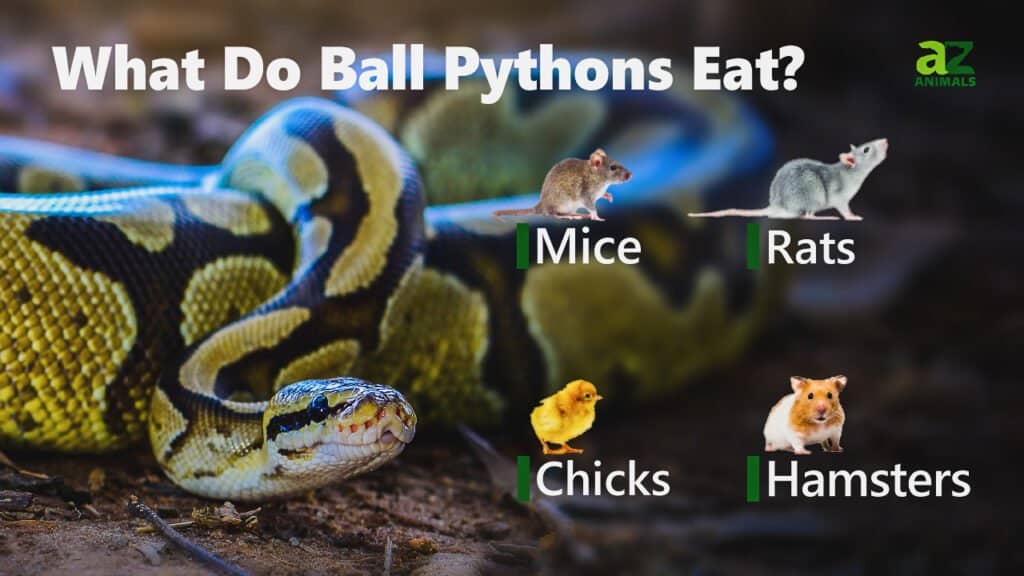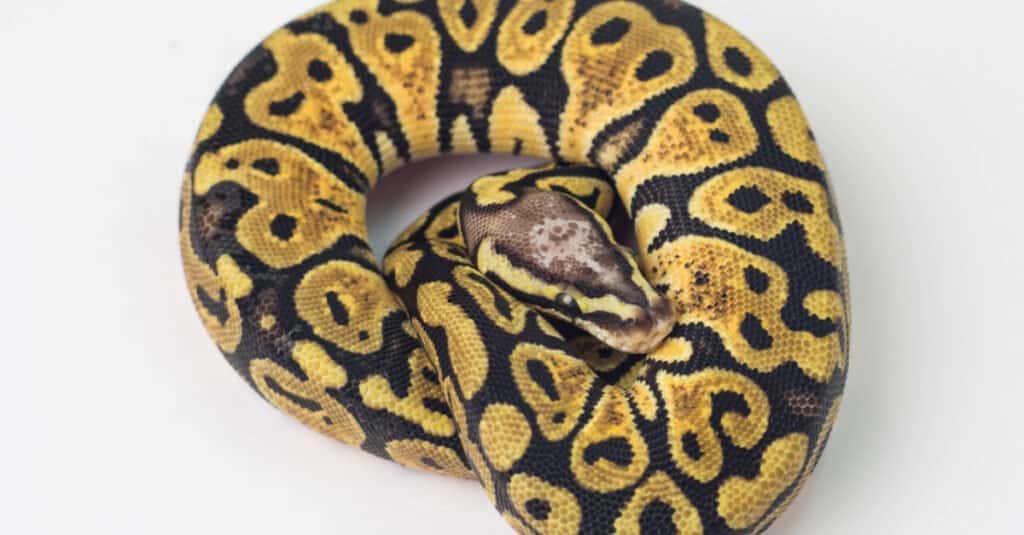Ball pythons are popular pet snakes. They are docile and easy to care for, making them terrific snakes for beginners and snake enthusiasts. Even though most ball pythons have their food easily handed to them, those in the wild still have to do all the hard work to get their food. But thanks to their impressive hunting skills, ball pythons can easily hunt their victims down. Compared to other snakes, ball pythons are considered medium-sized, growing only up to 39 inches in the wild. Relative to their size, they eat smaller prey as well. Ball pythons eat almost the same diet in captivity and the wild, but those in their natural habitat have more options and are more opportunistic.
Also called royal pythons, ball pythons are native to West and Central Africa. They got their name because of their shy nature and defensive behavior –curling their heads and body into a ball every time they get frightened or intimidated. They inhabit shrublands, grasslands, and open forests and feed on prey usually smaller than them. Unlike most snakes in the wild, pythons are non-venomous, which is also why they are a favorite for pet snake choices. Despite their lack of venom, ball pythons are still skilled predators, killing their victims not with poison but with a tight squeeze.
What Do Ball Pythons Eat?

Ball pythons are obligate carnivores who eat a diet that consists of small prey such as rodents, birds, amphibians, fish, and shrews. Ball pythons eat only once every one to two weeks in the wild. Like other snake species, ball pythons take a long time digesting their food, so it takes them a few days after eating before they start hunting again. Unlike large snake species, ball pythons do not eat larger prey than them. The size of their preferred prey always equates with the width of the ball python’s largest body part.
Their favorite food in the wild are rodents, as any small rodent can quickly be overpowered in the wild. As ambush predators, they use their keen senses to stalk and wait for their prey for days until they get the perfect opportunity to kill them. When ball pythons wander and come across nesting birds in their habitat, they will consume them too.
What Do Ball Pythons Eat as Pets?

Pet ball pythons eat frozen mice or rats.
©Krisda Ponchaipulltawee/Shutterstock.com
Ball pythons in captivity acquire food much easier than in the wild, but their diet must still be as sufficient inside cages as they are in their natural habitat. Pet ball pythons can eat a carnivorous diet, including large crickets and live or frozen mice or rats. Some ball python experts believe that only a specific life stage of rats should be fed to ball pythons, which are those in their younger ages, just about the size of a pinky mouse.
Here is the list of animals ball pythons eat as pets:
The widest part of a ball python is its middle body, around an inch wide. This means that only animals smaller than an inch can be fed to ball pythons. When a ball python eats prey larger than its stomach, it may regurgitate it or even have the food get stuck in its mouth or throat.
Ball pythons can eat only rats or mice for an entire lifetime, but they also love to spice up their diet in captivity and feed on other rodent species such as hamsters, gerbils, and other exotic breeds. Young ball pythons should only be fed with large crickets, fuzzy mice, and pinky mice until they grow into adults.
Many snake experts recommend feeding pet ball pythons with pre-killed prey instead of living prey. This is because living rodents and other live prey may fight back when the ball python is feeding on them, and the tiny mammal’s sharp teeth and claws may cause injuries. Ball pythons enclosed inside cages may not be as skilled as wild ball pythons in hunting, so they might have difficulty killing live prey. A safer option in feeding pet ball pythons is to serve pre-killed prey such as frozen or thawed mice.
What Size of Prey Should Ball Pythons Eat?

Ball pythons generally eat food smaller than their midsection.
©viper345/Shutterstock.com
Since ball pythons are not as voracious as other apex predator snakes, they need smaller food. Generally, ball pythons should only be fed with prey not larger than the snake’s midsection.
Pinky mice are a safe choice for ball python food as these baby mice weigh only one to three grams and are high in protein and low in fat content. For rats, however, ball pythons are best fed only with rat pups which are generally about 5 grams in weight.
How Do Pythons Hunt and Eat in the Wild?
As ambush predators, ball pythons like to lie and wait in hiding until a potential victim walks by. Like all snake species, ball pythons use their forked tongues and Jacobson’s organs for hunting prey through smell. Below their nostrils are pit organs that help them “see heat” or locate their prey by following heat signals.
Since ball pythons are non-venomous, they kill their prey by coiling around its body and suffocating it as they wrap tighter and tighter until the victim falls dead. Like other constrictors, they swallow their prey whole after suffocating it, starting from its head.
How Often Should Ball Pythons Eat in Captivity?
Adult ball pythons are fed only once a week, while younger ones need sustenance at least once or twice every week. Since ball pythons do not chew their food, it takes them two to six days to digest their prey after swallowing, where a whole process of breaking down via gastric acids takes place. Warm and dark corners aid the python in easier digestion, and after they defecate, they can eat again within another day or two. As nocturnals, ball pythons will actively attack prey inside their cages during the night.
The photo featured at the top of this post is © viper345/Shutterstock.com
Discover the "Monster" Snake 5X Bigger than an Anaconda
Every day A-Z Animals sends out some of the most incredible facts in the world from our free newsletter. Want to discover the 10 most beautiful snakes in the world, a "snake island" where you're never more than 3 feet from danger, or a "monster" snake 5X larger than an anaconda? Then sign up right now and you'll start receiving our daily newsletter absolutely free.
Thank you for reading! Have some feedback for us? Contact the AZ Animals editorial team.






